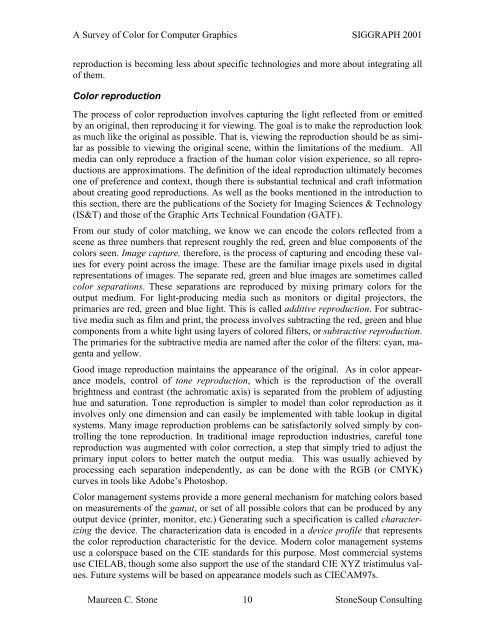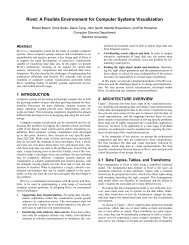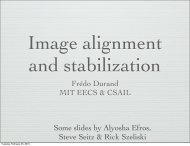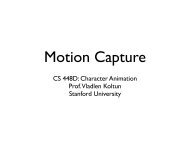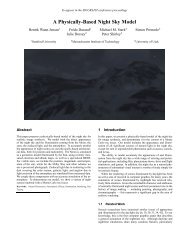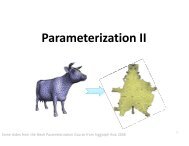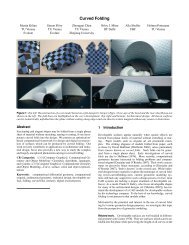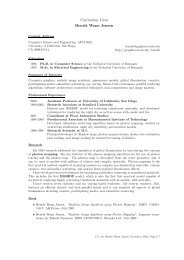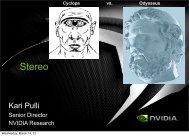A Survey of Color for Computer Graphics
A Survey of Color for Computer Graphics
A Survey of Color for Computer Graphics
You also want an ePaper? Increase the reach of your titles
YUMPU automatically turns print PDFs into web optimized ePapers that Google loves.
A <strong>Survey</strong> <strong>of</strong> <strong>Color</strong> <strong>for</strong> <strong>Computer</strong> <strong>Graphics</strong> SIGGRAPH 2001<br />
reproduction is becoming less about specific technologies and more about integrating all<br />
<strong>of</strong> them.<br />
<strong>Color</strong> reproduction<br />
The process <strong>of</strong> color reproduction involves capturing the light reflected from or emitted<br />
by an original, then reproducing it <strong>for</strong> viewing. The goal is to make the reproduction look<br />
as much like the original as possible. That is, viewing the reproduction should be as similar<br />
as possible to viewing the original scene, within the limitations <strong>of</strong> the medium. All<br />
media can only reproduce a fraction <strong>of</strong> the human color vision experience, so all reproductions<br />
are approximations. The definition <strong>of</strong> the ideal reproduction ultimately becomes<br />
one <strong>of</strong> preference and context, though there is substantial technical and craft in<strong>for</strong>mation<br />
about creating good reproductions. As well as the books mentioned in the introduction to<br />
this section, there are the publications <strong>of</strong> the Society <strong>for</strong> Imaging Sciences & Technology<br />
(IS&T) and those <strong>of</strong> the Graphic Arts Technical Foundation (GATF).<br />
From our study <strong>of</strong> color matching, we know we can encode the colors reflected from a<br />
scene as three numbers that represent roughly the red, green and blue components <strong>of</strong> the<br />
colors seen. Image capture, there<strong>for</strong>e, is the process <strong>of</strong> capturing and encoding these values<br />
<strong>for</strong> every point across the image. These are the familiar image pixels used in digital<br />
representations <strong>of</strong> images. The separate red, green and blue images are sometimes called<br />
color separations. These separations are reproduced by mixing primary colors <strong>for</strong> the<br />
output medium. For light-producing media such as monitors or digital projectors, the<br />
primaries are red, green and blue light. This is called additive reproduction. For subtractive<br />
media such as film and print, the process involves subtracting the red, green and blue<br />
components from a white light using layers <strong>of</strong> colored filters, or subtractive reproduction.<br />
The primaries <strong>for</strong> the subtractive media are named after the color <strong>of</strong> the filters: cyan, magenta<br />
and yellow.<br />
Good image reproduction maintains the appearance <strong>of</strong> the original. As in color appearance<br />
models, control <strong>of</strong> tone reproduction, which is the reproduction <strong>of</strong> the overall<br />
brightness and contrast (the achromatic axis) is separated from the problem <strong>of</strong> adjusting<br />
hue and saturation. Tone reproduction is simpler to model than color reproduction as it<br />
involves only one dimension and can easily be implemented with table lookup in digital<br />
systems. Many image reproduction problems can be satisfactorily solved simply by controlling<br />
the tone reproduction. In traditional image reproduction industries, careful tone<br />
reproduction was augmented with color correction, a step that simply tried to adjust the<br />
primary input colors to better match the output media. This was usually achieved by<br />
processing each separation independently, as can be done with the RGB (or CMYK)<br />
curves in tools like Adobe’s Photoshop.<br />
<strong>Color</strong> management systems provide a more general mechanism <strong>for</strong> matching colors based<br />
on measurements <strong>of</strong> the gamut, or set <strong>of</strong> all possible colors that can be produced by any<br />
output device (printer, monitor, etc.) Generating such a specification is called characterizing<br />
the device. The characterization data is encoded in a device pr<strong>of</strong>ile that represents<br />
the color reproduction characteristic <strong>for</strong> the device. Modern color management systems<br />
use a colorspace based on the CIE standards <strong>for</strong> this purpose. Most commercial systems<br />
use CIELAB, though some also support the use <strong>of</strong> the standard CIE XYZ tristimulus values.<br />
Future systems will be based on appearance models such as CIECAM97s.<br />
Maureen C. Stone 10<br />
StoneSoup Consulting


